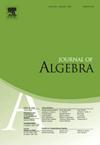Pushforward of Siegel flag varieties in the Chow ring
IF 0.8
2区 数学
Q2 MATHEMATICS
引用次数: 0
Abstract
Given a reductive group G over an algebraically closed field and subsets of the simple roots Δ determined by a choice of maximal torus and Borel subgroup, there is a closed embedding of flag varieties . In this paper we compute the class of the sub flag variety in the Chow ring for the ‘Siegel’ case where G is a general symplectic group of semisimple rank g and is the parabolic stabilising a maximal isotropic subspace. This corresponds, under the isomorphism with the tautological ring of the moduli space of principally polarised abelian varieties , to the generator of the classes in the tautological ring which are supported on the toroidal boundary. This provides basic evidence for a conjecture describing the tautological ring of a Hodge-type Shimura variety.
西格尔旗品种在周氏环上的推广
给定一个代数闭域上的约化群G和由极大环面和Borel子群的选择决定的简单根Δ的子集I,J∧Δ,则存在标志变量LJ/LJ∩PI“G/PI”的闭嵌入。在“Siegel”情况下,我们计算了Chow环上子标志变化[LJ/LJ∩PI]∈A•(G/PI)的类,其中G是半单秩G的一般辛群,PI是稳定极大各向同性子空间的抛物。在与主极化阿贝变体T•(Agtor) = A•(G/PI)的模空间的同构条件下,这对应于在环面边界上支持的同构环中的类的生成。这为描述霍奇型志村变种的同义环的一个猜想提供了基本证据。
本文章由计算机程序翻译,如有差异,请以英文原文为准。
求助全文
约1分钟内获得全文
求助全文
来源期刊

Journal of Algebra
数学-数学
CiteScore
1.50
自引率
22.20%
发文量
414
审稿时长
2-4 weeks
期刊介绍:
The Journal of Algebra is a leading international journal and publishes papers that demonstrate high quality research results in algebra and related computational aspects. Only the very best and most interesting papers are to be considered for publication in the journal. With this in mind, it is important that the contribution offer a substantial result that will have a lasting effect upon the field. The journal also seeks work that presents innovative techniques that offer promising results for future research.
 求助内容:
求助内容: 应助结果提醒方式:
应助结果提醒方式:


